Students will analyze Trade Canoe for Don Quixote and explore how Jaune Quick-to-See Smith used objects and symbols to express her views on the Iraq War, war in general, and other political issues. In contrast, students will create their own painting that reflects a positive cultural exchange.
Students will be able to:
- analyze the political theme of Trade Canoe for Don Quixote; and
- create a painting that expresses a political theme or message
Lesson
- Invite students to team up with a partner and discuss a time when they traded something with a friend or someone they knew. What items did they trade? Did both parties feel that this was a good trade? Why or why not? What makes a trade “good” or fair/equitable? Ask volunteers to share their answers with the entire class.
- Explain that canoes were originally used by only American Indian communities for transportation, trade, and communication. Later, however, Europeans and Americans adopted them.
- Looking at Trade Canoe for Don Quixote, ask the students what kinds of objects they observe in the trade canoe. Are these the kinds of objects that they would either want to give or receive? Why might the artist have included these types of objects in the trade canoe?
- Using the About the Art section for this piece, explain that the artist is trying to make a statement about things in the world that she perceives as being unfair or unjust. (You might want to explain to older students that the artist is referencing the Iraq War, or, in general, point out that there are times when nations, communities, and individuals make unfair exchanges.) She is showing things that she would want to trade for positive things, such as peace and respect. Ask the students to describe some situations in the world, the local community, or their own lives that they think are unfair or unjust.
- In contrast, ask the students to think about the kinds of things that they think should be included in trade canoes. What kinds of objects would be good for nations, communities, or individuals to trade?
- After brainstorming positive objects, pass out paper, paintbrushes, and paint and have the students create a painting of a canoe carrying these positive objects. Students could also cut open a paper towel roll and unroll it to create a canoe-shaped vessel that can hold things. They could paint it, staple the edges to a piece of paper, then fill the canoe with small objects—or representations of those objects made from construction paper—that might have been traded.
Materials
- Large piece of paper for each student
- Tempera paints and paintbrushes
- Optional: Empty paper towel roll for each student and miscellaneous scraps of construction paper
- About the Art section on Trade Canoe for Don Quixote (included with the lesson plan) or student access to this part of Creativity Resource online
- One color copy of the painting for every four students, or the ability to project the image onto a wall or screen
Standards
- Visual Arts
- Invent and Discover to Create
- Observe and Learn to Comprehend
- Relate and Connect to Transfer
- Language Arts
- Oral Expression and Listening
- Critical Thinking & Reasoning
- Information Literacy
- Invention
- Self-Direction
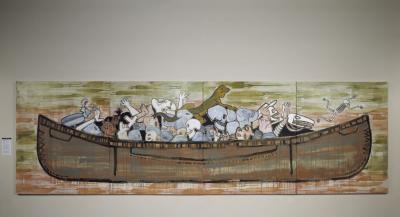
Trade Canoe for Don Quixote
60 in. x 200 in.
William Sr. and Dorothy Harmsen Collection, by exchange, 2005.62
Photograph © Denver Art Museum 2009. All Rights Reserved.
Artist Jaune Quick-to-See Smith says, “My work is about enlightening the larger community about Indian affairs today. I can’t do anything about the past, but I can do something about the present and future.” Smith was born in Montana on the Confederated Salish and Kootenai Indian Reservation in 1940. She studied art education in Massachusetts and received her Master of Fine Arts degree at the University of New Mexico. Smith uses painting, collage, and images from popular culture and from other artists to create her works. She has been described as “a bridge builder” between cultures. She says, “My art, my life experience, and my tribal ties are totally enmeshed. I go from one community with messages to the other, and I try to enlighten people.” Inspired by artists like Pablo Picasso as well as traditional American Indian art, Smith’s work tends to address myths of American Indians in the context of current issues.
“My best hope is that a viewer sees something about the human condition, that might cause them to pause a moment and consider something like war,” says Jaune Quick-to-See Smith. Trade Canoe for Don Quixote focuses on a canoe, a traditional form of transportation among some American Indian tribes. Europeans and Americans eventually adopted canoes and used them to bring U.S. government policies into Indian country. According to Smith, this painting “moves the trade canoe to a more massive war canoe such as the ocean going canoes on the Pacific Rim. Besides the wars in the Middle East, perpetrated by the U.S., there are other issues that are fought politically in a war-like way. These issues might be as varied as a woman’s right to choose for her own body; healthy natural foods versus unhealthy processed foods that are controlled by massive corporate campaigns; the consumer culture issues which are controlled by international corporations versus living in a sustainable way …” In this painting, Smith has filled the trade canoe with war images from throughout history that, for her, represent some of these issues. She goes on to say, “Can we trade all this for peace, respect, kindness, friendship, sustainability, and a caring for our planet and all its inhabitants.”
Smith is strongly influenced by other artists and often references images from art history in her paintings. In Trade Canoe, Smith’s skeletons are rendered in a similar style to those of Mexican painter Jose Guadalupe Posada in his work Calavera de Don Quijote. Like Smith’s work, Posada’s artwork protested his government’s policies. Smith also painted images of faces and heads that are similar to those painted by Pablo Picasso in his famous painting Guernica, another piece filled with political commentary. She says, “I think that Picasso’s Guernica is one of the greatest pictures of war showing the suffering of humans and animals.”
Details

Canoe
The canoe in this painting resembles a birch bark canoe. Birch bark was the most popular type of bark used to make canoes.
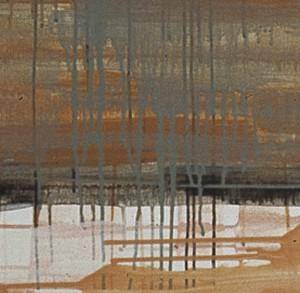
Paint Drips
This painting is constructed of four separate canvases that have been put together to form one horizontal rectangle. Smith would apply paint to one piece of canvas and then rotate it while the paint was still wet, creating thick streaks of paint that move across the canvas in all directions. “I felt that it conveyed a desert mirage of water,” she says.
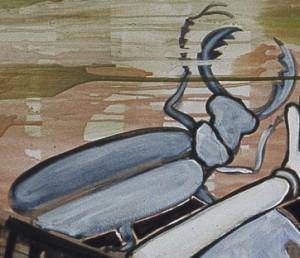
Beetles
“In making a picture about the trashing of war, the beetles seemed appropriate in the spoilage,” says Smith.
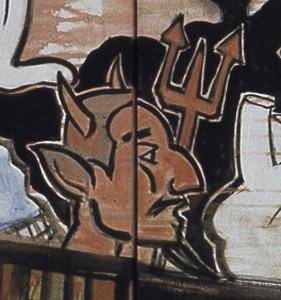
Devil
The devil is an image that is depicted in paintings throughout history, and particularly in religious paintings. “Most wars are fought over religious differences, particularly our recent wars,” Smith says. “I drew from all periods of art history and from various religions in depicting the ruins of war.”

Pepsi Can
This is a reference to a Pepsi factory that was built in Iraq during President Bush’s administration in hopes of helping the economy there. Smith feels that there are both pros and cons to this.
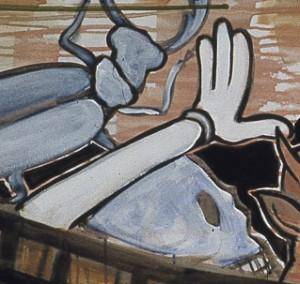
Mickey Mouse Hand
For Smith, the Mickey Mouse hand represents the American icons—like Pepsi or McDonald’s—that are forced upon other countries when Americans occupy them.
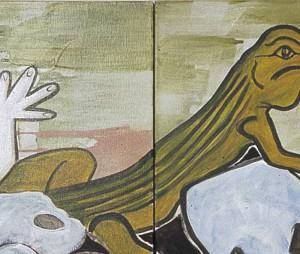
Lizard
Smith took the image of a dragon, which appears in religious paintings throughout art history, and changed it into a lizard to reference the lizards found in the Iraqi desert.

Color
The colors in this painting aren’t the typical blues that would indicate the canoe is in water. Instead, Smith uses pinks, oranges, and greens to reference the colors of a desert storm.
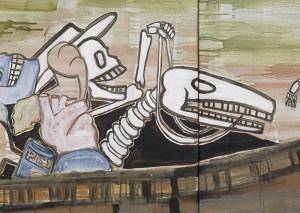
Skeleton Riding a Skeleton Horse
Smith’s skeletons (specifically the skeleton with a hat riding a skeleton horse, as well as the smaller one hurling itself out of the canoe) are similar to José Guadalupe Posada’s skeletons in his print Calavera de Don Quijote y Sancho Panza (made around the turn of the century). The title Trade Canoe for Don Quixote also references the title of Posada’s image. You can see the image at the Library of Congress' online illustrated guide here (click on the image’s title to view the print at a larger size).

Guernica Reference
Smith references images of faces and heads from Pablo Picasso’s painting Guernica (1937). Picasso’s painting shows faces twisting upward in anguish. Picasso painted this piece as a statement against fascism after Adolf Hitler used the Spanish village of Guernica for bombing practice. You can see information and illustrations of Guernica here.
Funding for object education resources provided by a grant from the Morgridge Family Foundation. Additional funding provided by the William Randolph Hearst Endowment for Education Programs, and Xcel Energy Foundation. We thank our colleagues at the University of Denver Morgridge College of Education.
The images on this page are intended for classroom use only and may not be reproduced for other reasons without the permission of the Denver Art Museum. This object may not currently be on display at the museum.







